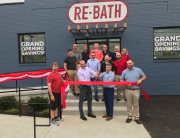Surging demand halts applications to low-interest loan program
by Paula Holzman
Central Penn Business Journal, June 18, 2009
A state-administered low-interest loan program to boost the state’s agriculture and tourism industries has temporarily stopped taking applications because demand has outstripped supply.
The First Industries Fund began in 2005 and included a $100 million revolving loan program funded by the Commonwealth Financing Authority (CFA) to support agriculture.
But that entire sum, in addition to all the loan repayments the fund has received of about $14 million, have been committed, said Scott Dunkelberger, executive director of the CFA.
“The demand has been tremendous for this program,” he said Wednesday. “As of last week, we’re closed for applications until such time that sufficient repayment allows us to open another round.”
He said he anticipated reopening the program toward the end of the year.
“We didn’t want folks counting on First Industries, only to be told there are no funds,” he said. “We’ve got just enough applications to use the money we have.”
The shrinking availability of credit and the reduction in risk to a private lender that comes with a First Industries Fund loan have contributed to the program’s popularity, Dunkelberger said.
But what caused a blizzard of applications was the CFA’s announcement that program interest rates would rise from 3 percent to 5 percent as of June 1, he said.
“We’ve had a run on the bank in the last two months, and certainly in the last 30 days,” Dunkelberger said.
Under program guidelines, farmers may receive loans of up to $200,000 or up to half the value of a given project, whichever is less, for a land purchase. Before June 1, farmers could receive loans for equipment or machinery of up to $5 million; the CFA lowered that ceiling to $500,000 as of June 1, Dunkelberger said.
Many of both types of loans have gone to midstate farms and agribusiness, particularly in Lancaster County.
Lancaster County has accounted for 24 percent of the combined public and private investment in projects funded by the loans, said Lyle Hosler, project manager with the Economic Development Company of Lancaster County (EDC), which administers the program there.
The EDC has secured $16.7 million from the fund since it began in 2005 — a total of 82 projects spanning 6,317 acres of county land.
“The Economic Development Company of Lancaster has done an excellent job in packaging this program,” Dunkelberger said.
Among the recipients were Scott and Jennifer Gochenaur, who used their $200,000 First Industries Fund loan to help purchase a 21-acre farm in Mount Joy Township, where they now are raising 120,000 laying hens.
Using the First Industries loan has saved the Lancaster County family about $6,000 a year, Scott Gochenaur said.
The family still would have been able to buy the property without the First Industries loan, but Gochenaur said some other people might not be able to afford a land or equipment purchase without it.
“It’s tight now for farmers,” said Juanita Garber, a Cumberland County dairy farmer who benefitted from a First Industries Fund loan last year. “Hopefully, the fund will come back again or there will be a fund of a similar setup.”
Garber and her husband, Zane, used the loan to purchase a 150-acre farm in Southampton Township, which they named Rock Solid Dairy.
“I feel sorry for those who can’t get (these loans),” she said.
Lancaster County dairy farmer Joe Garber said although it’s a difficult time for agriculture statewide, he sees a bright spot in demand for the loans outpacing supply.
“What that tells me is that the banks are supporting this concept,” said Garber, who received a $500,000 equipment loan to upgrade the milking parlor at Spring Lawn Farm, the 128-acre Pequea Township dairy he owns with his brother and son.
What a reopened First Industries Fund loan program might look like — especially in terms of volume — remains uncertain.
“Things are tough all around with the revenue shortfall with the state,” Dunkelberger said. “I don’t see a lot of room for any recapitalization through direct investment or appropriations. We’re going to have to get creative.”
copyright ©2009 Central Penn Business Journal. Used with permission.






Recent Comments